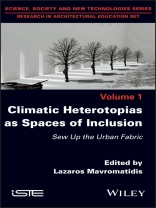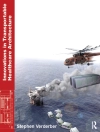This book explores, discusses and considers spatial research and its relevant pedagogic perspectives on the crossings, interactions and transformations of contemporary territorialities. The book addresses the issue of conceiving ‘translocal’ spaces of inclusion within the framework of contemporary imposed nomadism and climate change. The concept of ‘climatic heterotopias’ is an original, elegant concept, introduced into the pedagogy of architecture to develop teaching which aims to bring together the architectural substance and this real social need that aims to mitigate the spatial effects of climate change.
Climatic Heterotopias as Spaces of Inclusion promotes the use of spatial theory and philosophy as the tools to build a strong architectural concept. The purpose of the individual contributions in the book is to introspectively explain the original concept of ‘climatic heterotopias’. An overview is given of an innovative, penetrating pedagogic praxis intended to enhance intuition by transforming the architectural design studio into an interface where research is incorporated into everyday architectural conceptual practice, through interaction and openness. This book is a dynamic and implicit dialogue between the tutor and the learners which shapes, little by little, an alternative spatial narrative throughout architectural theory and design.
Cuprins
Preface ix
Chapter 1. Climatic Heterotopias Architectural Design Studio 1
Lazaros MAVROMATIDIS
1.1. Reinventing the political dimension of space throughout pedagogy 1
1.2. Reinventing an introspective pedagogy to enhance the architectural conscience of the learners 3
1.3. Tarrying with the Castoriadian ‘radical imaginary’ 4
1.4. Creation of an alternative pedagogical praxis: development of the ‘climatic heterotopia’ notion within a global climate regime. 5
1.5. Reinventing the ‘glocal’ dimension of space through a concrete exercise of ‘translocal’ space creation 7
1.6. Pedagogical program, content and constraints of the ‘climatic heterotopias’ architectural design studio 9
1.7. Intellectual outputs of the ‘climatic heterotopias’ architectural design studio 11
1.8. Synoptic overview of the ‘climatic heterotopia’ according to the students’ essays 12
Chapter 2. Of Other Climates: Glocal Climatic Constructal Heterotopias 23
Lazaros MAVROMATIDIS
Chapter 3. Redefine the Contemporary Spatio-social Mentalities 41
Carole BEAUFUMÉ
3.1. Change the mentalities: the first step of a sustainable transition 45
3.2. My climatic heterotopia: an economical,
ecological and social experiment 47
Chapter 4. Redefine the Body as the Physical Constitution of the Human Being 51
Claire AUBRY
Chapter 5. The Pause or Dreaming in the Woods 61
Estelle AURAY
Chapter 6. A Territory of One’s Own 69
Fleur LAGARRIGUE
Chapter 7. The Hegelian Dimension of Climate as a Feeling Atmosphere 75
Milan ENGSTRÖM
Chapter 8. Rhythm as the Tool to Create Heterochrony and Innovative Territorialities 83
Jonas KAMMERER
Chapter 9. Story for an Illusory Hope Against an Absurd Life 91
Bérénice VALLANCE
Chapter 10. The Fluidic Climatic Heterotopia – Fractures, Flows, Chaos, Composition 103
Vincent PAPAZIAN
10.1. The infinite fracture – anything is but continuous 103
10.2. The world seen as fluxes: interconnected ‘climatic heterotopias’ 106
10.3. Praising the overload: climatic heterotopia of movement and chaos 107
10.4. Composition 109
Chapter 11. Transmission 113
Mélodie PEZET
Chapter 12. Introspection 121
Aurore PEILLET
Chapter 13. Sew Up the Urban Fabric: The Architectural Project 129
Claire AUBRY, Estelle AURAY, Carole BEAUFUMÉ, Milan ENGSTRÖM, Jonas KAMMERER, Fleur LAGARRIGUE, Vincent PAPAZIAN, Aurore PEILLET, Mélodie PEZET, Bérénice VALLANCE and Lazaros MAVROMATIDIS
Chapter 14. The Auto-poetic Spirit of a Creative Learning Society Within a Multifaceted Context of Crises 157
Lazaros MAVROMATIDIS
References 161
List of Authors 167
Index 169
Despre autor
Lazaros Mavromatidis is an architect-engineer and holds a Ph D in Applied Thermodynamics from INSA (Institut National des Sciences Appliquées) Lyon and ENTPE (École Nationale des Travaux Publics de l’État), France. He is Associate Professor at INSA Strasbourg and a researcher in the ICube laboratory UMR 7357. His scientific publications as well as pedagogic and research interests cover the fields of urbanism, urban design/planning, aesthetics, architectural morphogenesis, architectural sustainable design, constructal and applied thermodynamics, building physics, innovative building envelopes and generative eco-conception.












